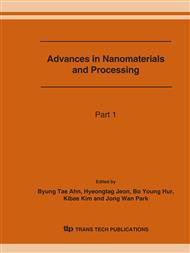p.1225
p.1229
p.1233
p.1237
p.1241
p.1245
p.1249
p.1253
p.1257
The Novel Methods for Preparing Antibacterial Fabric Composites Containing Nano-Material
Abstract:
This paper is to develop an antibacterial fabric by mainly radiation grafting technique. Because a fabric should be soft and comfortable, so antibacterial materials need to be very small in size to graft on the fabric. This work used nanosized antibacterial solution or powder, Nylon and PET fibers, as starting materials to prepare antibacterial fabric products. Two radiation synthetic processes were used in the paper, 1. the nanosized silica powder or solution containing silver (named Ag/SiO2) was introduced to Nylon or PET (Polyethylene terephthalates) fabric by means ofγ-ray irradiation method. 2. the nanosized silver particles in solution were reduced and deposited on the surface of fabric used by radiation reduction technique. The microscope TEM & SEM (transmission and scanning electron microscope) and ICP(Induced coupled plasma)…etc were utilized to analyze the characteristics of antibacterial fiber products. In addition, these antibacterial fibre products prepared by radiation reduction method were also subjected to test the antibacterial effect.The results showed that silver-Nylon and silver-PET antibacterial fiber have good antibacterial effects against Staphylococcus aureus , especially the Ag-PET fiber having the better effect than Ag-Nylon fiber.
Info:
Periodical:
Pages:
1241-1244
Citation:
Online since:
June 2007
Authors:
Keywords:
Price:
Сopyright:
© 2007 Trans Tech Publications Ltd. All Rights Reserved
Share:
Citation:


